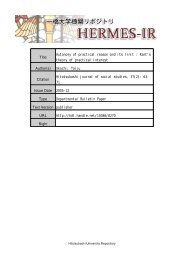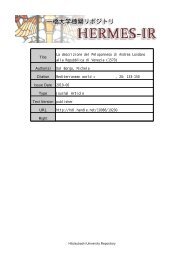intermodal transport and city logistics policies - HERMES-IR
intermodal transport and city logistics policies - HERMES-IR
intermodal transport and city logistics policies - HERMES-IR
Create successful ePaper yourself
Turn your PDF publications into a flip-book with our unique Google optimized e-Paper software.
8 City Logistics IV<br />
integrators” specialising in the integrated, seamless <strong>transport</strong> of full loads at the European <strong>and</strong><br />
global level.<br />
American <strong>intermodal</strong> <strong>and</strong> <strong>city</strong> <strong>logistics</strong> policy<br />
Efficient <strong>logistics</strong> system in North America is indispensable for the North America Free Trade<br />
Agreement (NAFTA) involving the U.S., Canada <strong>and</strong> Mexico. Because of the size of its<br />
economy <strong>and</strong> its central geographical location, the U.S. has a factual leadership position <strong>and</strong><br />
has taken initiatives in enhancing <strong>intermodal</strong> <strong>logistics</strong> <strong>and</strong> <strong>transport</strong> in the region. The original<br />
milestone of American <strong>intermodal</strong>ism was the Intermodal Surface Transport Efficiency Act of<br />
1991 (ISTEA ’91) which provided the legislative framework to develop “a National Intermodal<br />
System that shall consist of all forms of <strong>transport</strong>ation in a unified, inter-connected manner”.<br />
Table 4 summarises the essential elements of the U.S <strong>intermodal</strong> policy. Its basic philosophies<br />
are: 1) <strong>intermodal</strong> is industry <strong>and</strong> market driven, <strong>and</strong> 2) government acts as a convener <strong>and</strong><br />
catalyst, i.e. few public sector interventions <strong>and</strong> few governmental initiatives.<br />
Table 4 Elements of <strong>intermodal</strong> policy in the U.S.<br />
Infrastructure Technology Rules <strong>and</strong> St<strong>and</strong>ards<br />
• National corridor development<br />
• Coordinated border<br />
infrastructure program<br />
• NHS <strong>intermodal</strong> freight<br />
connectors<br />
• Intermodal cargo hubs<br />
• ITS <strong>intermodal</strong> freight program<br />
• Intermodal border clearance<br />
• R&D<br />
• Freight facilitation strategy<br />
• Freight partnerships<br />
• Freight analysis decision<br />
framework<br />
• Education & training<br />
• St<strong>and</strong>ards, “size & weight” of<br />
containers<br />
U.S. executive <strong>and</strong> legislative bodies are discussing the renewal of the next long-term <strong>transport</strong><br />
legislation, called SAFETEA, i.e. the Safe, Accountable, Flexible <strong>and</strong> Efficient Transport<br />
Equity Act. Several different drafts of the forthcoming legislation have been put forward <strong>and</strong>,<br />
as usual, discussions about funding <strong>and</strong> taxation are at the forefront. Broadly speaking, freight<br />
mobility, global connectivity, security <strong>and</strong> border infrastructure are among the priority goals.<br />
Restraint measures against freight vehicles in urban areas are not common in the U.S. except in<br />
large cities (e.g. New York). It is because there are few conflicts between urban activities or<br />
urban l<strong>and</strong> uses (e.g. commercial <strong>and</strong> residential uses), owing to spacious area <strong>and</strong> strict l<strong>and</strong><br />
use controls.<br />
Japanese <strong>intermodal</strong> <strong>and</strong> <strong>city</strong> <strong>logistics</strong> policy<br />
According to the OECD report prepared by the Asian Task Force (2003), several countries<br />
including Singapore, Korea <strong>and</strong> Japan have developed well-defined comprehensive <strong>logistics</strong><br />
<strong>policies</strong>. Most of the countries, however, have mode-specific freight <strong>transport</strong> <strong>policies</strong>, while<br />
Malaysia <strong>and</strong> the Philippines explicitly refer to the importance of <strong>intermodal</strong>ity. Clearly, it will<br />
take some time to have a region-wide <strong>intermodal</strong> <strong>logistics</strong> policy in Asia. In this paper<br />
therefore, we concentrate on reviewing Japanese <strong>logistics</strong> <strong>policies</strong> as an Asian case study.










